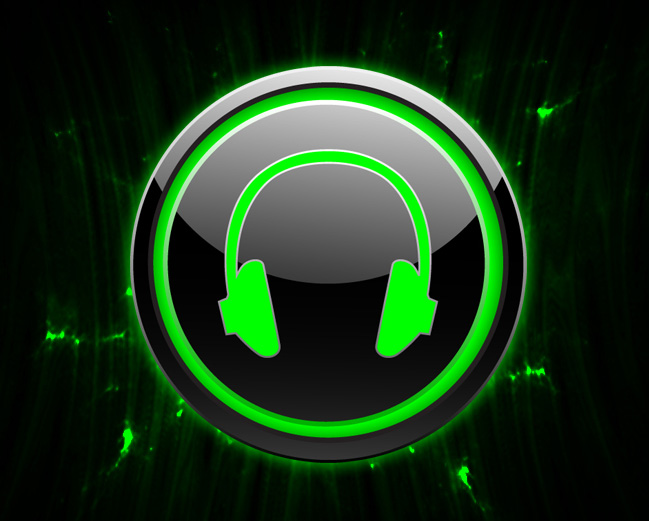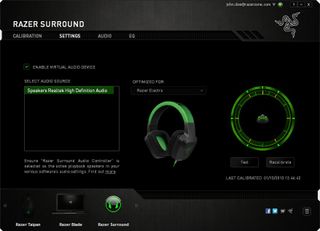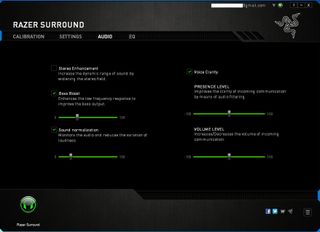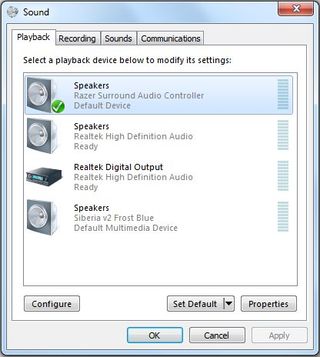Razer Surround Impressions

Razer Surround: Can virtual surround sound software do the job of a real 7.1 headset?
Razer Surround is a program for gamers to get surround sound from any pair of headphones, be it Razer or otherwise. That’s right, install it and Razer claims that you’ll have “the best virtual 7.1 channel surround sound experience [possible] with any stereo headphones.”

The Razer Surround software is currently free up to 2014.
Although Razer is a bit vague about how exactly Razer Surround works, it seems that it’s simply a repackaged and rebranded version of the Maelstrom Audio Engine that they bundled with the Megalodon back in 2008. Now they’re providing it as an add-on to Razer Synapse —Razer’s “cloud-based setting network for gamers.” If you currently use a Razer Mouse or any of their more recent peripherals, you probably already have Razer Synapse installed and running. Razer Surround integrates with Synapse and shows up as a tab on the bottom of the window.
All you need to get it running is to go through the quick setup and calibration process and you’ll be ready to start using Razer Surround. Yes, it does work, but not without some caveats. It doesn’t even come close to the experience of using an actual 5.1 or 7.1 speaker system, but it does turn any stereo headphones into a virtual surround sound experience.
If you’re listening to any sort of audio that’s only been encoded for stereo sound, you might run into some problems. Although it varied depending on the headphones we used and the audio that we listened to, Razer Surround can definitely have a negative effect on sound quality. By making the sound stage artificially wider, the software can end up making things sound hollow or empty. It’s not always obvious or noticeable, but it happens.
Games are where Razer Surround shines. Whether it’s Counter-Strike: Global Offensive or Battlefield 3 , the virtual surround sound works like a charm. Enabling the software to run Battlefield 3 instantly made things seem more real. Bullets whizz by and give you a noticeably better sense of their origin, the sound of tank treads emanates audibly from a specific direction. The chaos of hearing grenades explode around you are intensified, and distinct. The experience almost goes so far as to make you completely forget that you're playing a game, but rather sitting around and absorbing everything that’s happening around you. It's very satisfying.
Counter-Strike: Global Offensive doesn’t really try to provide an immersive experience, but it’s a game that benefits from positional awareness. Being able to hear footsteps around corners and through walls is absolutely essential. Anyone who’s ever used virtual or actual surround sound in Counter-Strike knows just how much of an impact it can make, and Razer’s implementation is no exception.
The biggest gaming news, reviews and hardware deals
Keep up to date with the most important stories and the best deals, as picked by the PC Gamer team.
All-in-all, Razer Surround isn’t anything new. Creative and Dolby have had their respective virtual surround sound technologies for years and have been licensing them out to headphone manufacturers and games alike. What separates Razer Surround is that it’s a piece of standalone software that doesn’t require a USB dongle or a specific headset. It also has one of the simplest interfaces that we’ve had the pleasure of using.

Razer Surround has a very simple interface
Most of the software bundled with headphones and sound cards are pretty horrific—buggy, ugly, and only half-functional. Razer Synapse may not be perfect, but Razer Surround works really well with it. All of the settings have simple checkboxes and sliders that look good and work as you’d expect. Extra features like the bass boost and the EQ are easily accessible and work surprisingly well.
Bass boost is something that gets tossed around a lot. People either seem to love it or hate it. Razer’s bass boost works fine and can help enhance the bass in any type of audio. We found that the ideal amount of bass boost depends on what you’re using it on. Some songs benefited from cranking it up while others were ruined by the excessive bass. At max, the bloated bass ends up ruining the mids and highs, but when used in moderation it really does help make the bass punchier and more pronounced. Keep cranking it up and the bass will get progressively looser and less enjoyable, eventually overpowering any vocals in the song.
The voice clarity and volume options work. They don’t work nearly as well as you’d like, but if you’re having problems hearing your friend over game noise this should be helpful (although you could always turn down the game's in-game audio instead). Much like the bass boost, both of these settings are best used in moderation. Turning up either too much can cause noticeable degradation in audio quality for both the voices and the other sounds. It seems that the software actively amplifies voices while simultaneously cutting back on other sounds.
If you’re worried about CPU and memory usage, don’t be. Running on anything even close to modern hardware, you’d be hard pressed to notice that Synapse or Surround is running. Their combined CPU utilization hovered around 5% on the low-end system that we used for testing.
Compared to the virtual surround sound offered by Creative and Dolby, this seems like a step up in almost every regard. Creative’s SBX Pro Studio Surround sounds tinny, hollow, and doesn’t even seem to help with positioning. Dolby Headphone is a bit better and probably has the edge in terms of creating a sterile surround sound effect, but it makes everything sound worse. Plus, neither of the two offers as many options and features as Razer Surround does.

Enabling/disabling Razer Surround is really easy.
It may not be ideal for use with music or videos that aren’t encoded for 5.1 or 7.1, but it’s great for games. Fortunately, Razer Surround has the option to create a virtual audio device that shows up in as a separate playback device. This allows you to easily switch between your standard audio device and Razer Surround at will.
Grab Razer Surround while it’s available for free for Windows XP, 7, 8. It’ll be jumping back up to $20 on January 1, 2014.
Alan has been writing about PC tech since before 3D graphics cards existed, and still vividly recalls having to fight with MS-DOS just to get games to load. He fondly remembers the killer combo of a Matrox Millenium and 3dfx Voodoo, and seeing Lara Croft in 3D for the first time. He's very glad hardware has advanced as much as it has though, and is particularly happy when putting the latest M.2 NVMe SSDs, AMD processors, and laptops through their paces. He has a long-lasting Magic: The Gathering obsession but limits this to MTG Arena these days.
Most Popular





